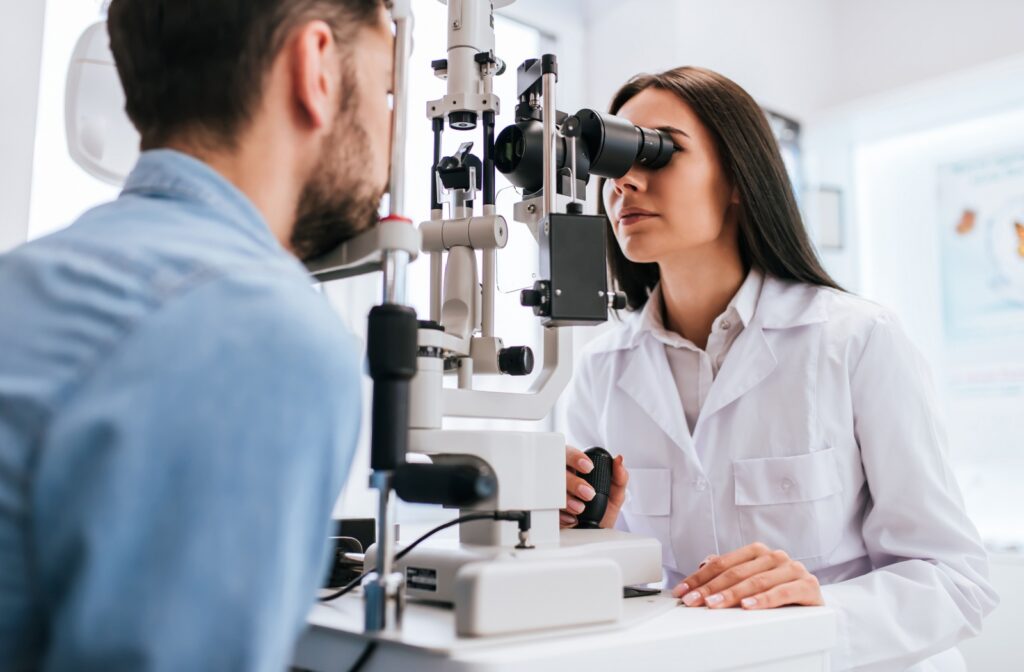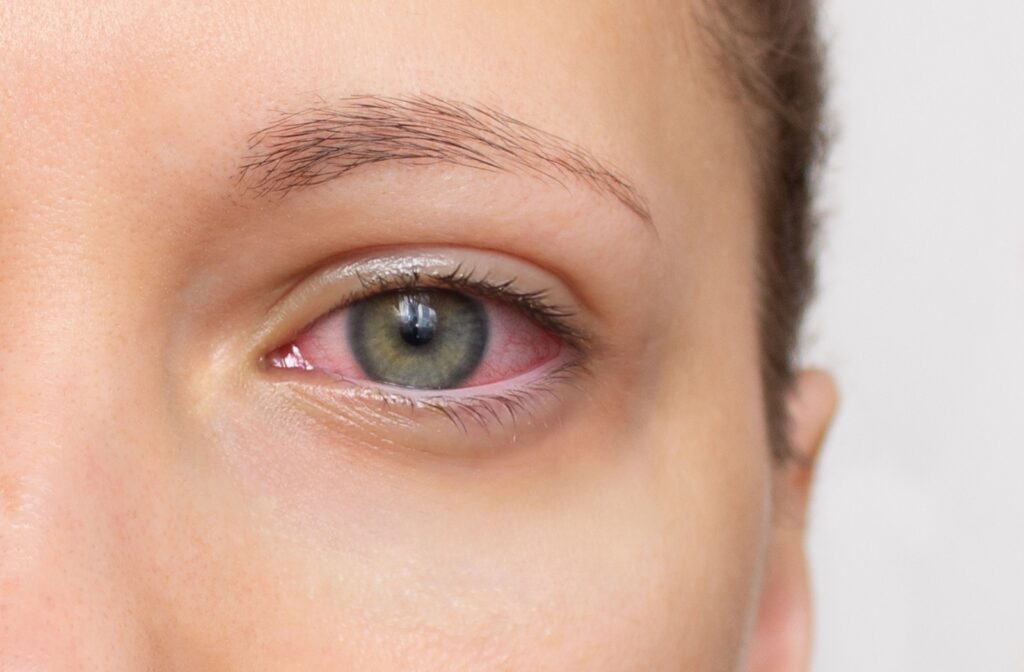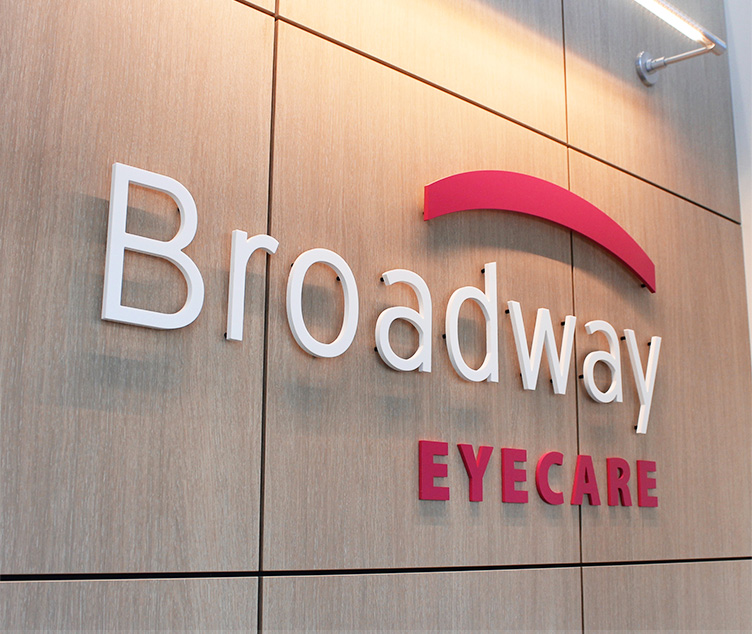Red, watery, and irritated eyes can actually point to a number of eye conditions. Your mind might immediately think “pink eye” (after all, it does look a little pink), but pink eye isn’t always the culprit behind these symptoms.
Pink eye (or conjunctivitis) is not an umbrella term for eye irritation. It’s a distinct condition with symptoms and treatments that depend on the type of conjunctivitis a person has. Pink eye also shares symptoms with several other eye conditions, including:
- Allergies
- Blepharitis
- Corneal Abrasions
- Dry Eye
- Styes and Chalazia
No matter the symptoms, the path to healing starts with an accurate diagnosis. A comprehensive evaluation with your eye doctor helps determine the right course for treatment.
Allergic Reactions
Technically, allergic conjunctivitis is a type of pink eye. However, the normal concern with pink eye is exposure to its contagious strains: bacterial and viral. Allergic conjunctivitis develops from an allergic reaction, and thankfully, allergies are not contagious.
Allergic conjunctivitis frequently gets mistaken for infectious pink eye, but there are key differences. Allergic reactions typically affect both eyes simultaneously and come with intense itching—something rarely seen with bacterial conjunctivitis.
Seasonal allergens like pollen, dust mites, or pet dander can trigger this response. If your symptoms worsen during specific seasons or in certain locations, allergies are likely the culprit, not an infection.
You’ll often notice other allergy symptoms alongside the eye irritation, such as:
- Sneezing
- Runny nose
- Congestion
Artificial tears help soothe irritation, while antihistamines can help manage the reaction itself. After removing or avoiding the allergen, you’ll notice a significant improvement in your symptoms.
Blepharitis
Blepharitis is an inflammation of the eyelids that can make your entire eye area look red and irritated. Blepharitis is a chronic condition that affects the lash line and oil glands, causing crusty debris to accumulate along the lid margins. Pink eye, on the other hand, affects the conjunctiva, the thin membrane that protects the eye.
People with blepharitis often wake up with their eyelids stuck together from dried discharge—similar to some forms of pink eye. However, this inflammation primarily affects the eyelid edges rather than the conjunctiva. You might notice flaky skin around your lashes or feel like your eyelids are burning.
Blepharitis is often linked to skin conditions like rosacea or seborrheic dermatitis. Treatment focuses on eyelid hygiene (gentle wipes, cleansers, etc.) and managing underlying skin issues rather than on antibiotic drops (as with bacterial conjunctivitis) or managing symptoms (viral pink eye).
Corneal Abrasions
A scratched cornea, known as a corneal abrasion, can cause dramatic redness and pain that’s often mistaken for severe pink eye. Corneal abrasions happen more often than you might think—from rubbing your eyes too hard, from getting something in your eye, or even from sleeping in contact lenses.
The pain caused by a corneal abrasion is typically sharp and intense, much worse than the mild discomfort of most pink eye cases. You’ll often feel like something is stuck in your eye, and bright lights might become unbearable. The eye waters profusely as it tries to flush out what it thinks might be a foreign object.
This condition requires immediate attention. Unlike pink eye, which can often wait for a regular appointment, corneal abrasions need prompt evaluation to prevent infection and scarring.

Dry Eye
Dry eye probably tops the list of conditions mistaken for pink eye. This chronic condition develops when your eyes don’t produce enough tears or when your tears evaporate too quickly from the surface of the eye, leaving your eyes red, gritty, and uncomfortable.
The confusion likely stems from the fact that both conditions share symptoms of redness and irritation. Dry eye typically involves a scratchy, sandy feeling rather than the sticky discharge associated with bacterial conjunctivitis. You might also notice your eyes water excessively as they try to compensate for the dryness—a counterintuitive symptom that often puzzles people.
Dry eye is very common, especially for those who spend long hours looking at screens or live in dry climates. Unlike bacterial or viral pink eye, which usually resolves within a week or two with proper treatment, dry eye is a chronic condition that requires ongoing management.
Styes & Chalazion
A stye (hordeolum) or chalazion can cause significant eye redness and discomfort, leading people to assume they have pink eye. However, styes affect the eyelid rather than the conjunctiva, but the resulting inflammation can make the entire eye area appear infected.
Styes are bacterial infections of the eyelash follicles or oil glands, creating a painful, red bump on the eyelid. Chalazia are blockages of the oil glands that cause swelling but are typically painless. Both can cause the eye to water and appear red, mimicking conjunctivitis symptoms.
The telltale difference is the visible bump or swelling on the eyelid. With true pink eye, the eyelid remains unaffected while the white part of the eye becomes inflamed.
A warm compress 2-4 times a day for 15 minutes can help, but visit your optometrist to learn how to properly treat your stye or chalazion. The right approach makes all the difference.
Get the Right Diagnosis for Healthy Eyes
It’s frustrating when red, watery eyes interfere with your daily life. While pink eye is common, it isn’t the only explanation, and trying to treat the wrong problem can make recovery harder. A comprehensive exam helps pinpoint the exact cause, so you can start the right treatment and avoid unnecessary complications.
At Broadway Eyecare, we combine advanced diagnostic tools with compassionate care to ensure your eyes get the attention they deserve. Whether you’re dealing with pink eye or another issue, we’ll guide you every step of the way. Book your eye exam today and take control of your eye health with confidence.









